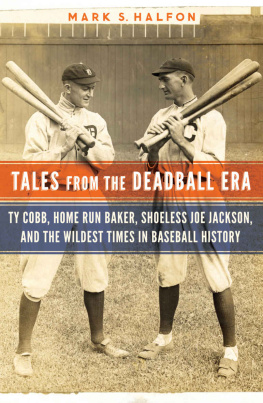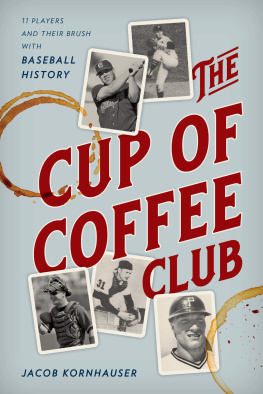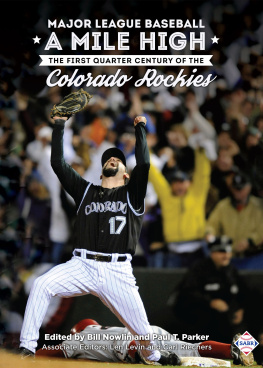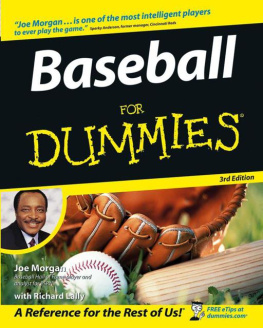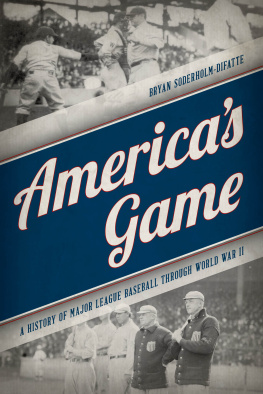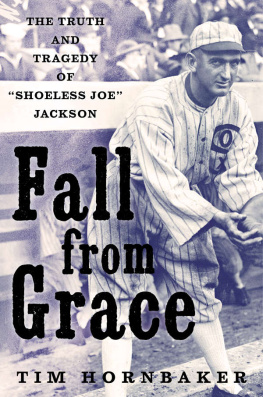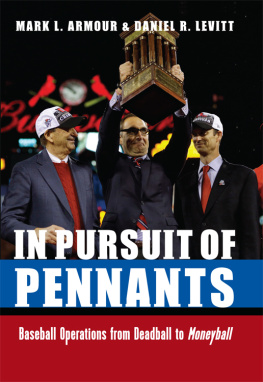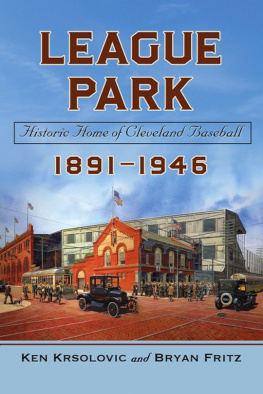TALES FROM THE DEADBALL ERA
TALES FROM THE DEADBALL ERA
Ty Cobb, Home Run Baker, Shoeless Joe Jackson, and the Wildest Times in Baseball History
MARK S. HALFON

2014 by the Board of Regents of the University of Nebraska. All rights reserved. Potomac Books is an imprint of the University of Nebraska Press. Manufactured in the United States of America

Library of Congress Cataloging-in-Publication Data
Halfon, Mark S.
Tales from the deadball era : Ty Cobb, Home Run
Baker, Shoeless Joe Jackson, and the wildest times in
baseball history / Mark S. Halfon.
pages cm.
Includes bibliographical references and index.
ISBN 978-1-61234-648-9 (cloth : alk. paper)
ISBN 978-1-61234-649-6 (pdf)
1. BaseballUnited StatesHistory20th century.
I. Title.
GV863.A1 H34 2014
796.357092dc23
[B]
2013041277
Set in Lyon Text by Renni Johnson.
Designed by A Shahan.
To Jonah and Lucas,
baseball fans of the future
CONTENTS
ACKNOWLEDGMENTS
Assists go to the late Gene Carney, Jim Clelland, Bill Deane, Eric Dryden, Jesse Halfon, Melissa Halfon, Nancy Halfon, Angela Napolitano, Larry Rapaport, Tom Sands, and Elizabeth Wheeler for their invaluable contributions. Special thanks to master linguist Ronna Feit, copyeditor Bojana Ristich, photographer Steve Richman, and my agent John Talbot, whose recommendations enhanced the final product.
The Society for American Baseball Research (SABR) provided a wealth of resources and John Horne, Library Associate in the Photo Archives at the National Baseball Hall of Fame, helped gather information about photographs for the book. Websites www.retrosheet.org, www.baseball-almanac.com, and www.baseball-reference.com served as constant guides.
All Major League records mentioned in the book date from the beginning of the modern era in 1901.
INTRODUCTION
After the Pittsburgh Pirates won Game One of the 1909 World Series, Everybody was on the streets, and you heard nothing, saw nothing, felt nothing, thought nothing but base ball [sic].Sporting News, October 14, 1909
The Deadball Era takes us back to a time when baseball was more than just a game. Hardened men battling to avoid the coal mines, cornfields, and ghettos from which they had come found a world where cheating for the sake of victory earned praise, wayward ballplayers fixed games, and violence came to be expected, if not anticipated. Endless fighting on the field and in the stands, between and among players and spectators, caused havoc, at times pushing the sport to the brink of anarchy. Excitement and danger awaited all who dared enter the confines of a Major League ballpark.
At the same time, lightheartedness and revelry found a prominent place in baseball. Fans ran onto the field in the middle of games with gifts for their favorite players; baseball stars volunteered for benefit contests to aid fellow players and the country in times of need; and joke games removed any hint of seriousness from the sport. Intriguing contradictions abounded.
The Deadball Era further tells of a period when Major Leaguers adopted a novel offensive philosophy. Instead of taking hard, full swings as had been a long-standing tradition, they poked or slapped at the baseball to reach base and manufactured runs ninety feet at a time. Bunting, sacrificing, and stealing now propelled offenses in a strategy that came to be known as inside baseball. This style of play dominated until 1920, when restrictions on the previously legal spitball, banning of freak pitches, introduction of a lively ball, and George Herman Babe Ruths majestic home runs contributed to a dramatic transformation of the sport. As one Deadball Era star reminisced,
You see, it was a different game then compared to today. Now theyre all trying to hit the ball over the fence. Its mostly brute strength. Theyre always trying to get a flock of runs at once. But in my day a home run was a rarity. You couldnt hit balls over the fence in most parks, because the ball was too dead! So we were always playing for small scores, for one run or two.
For example, take a simple thing like the art of getting hit with the ball when youre at bat. To get up there and deliberately attempt to get hit by a pitched ball. Its a lost art today; just not done anymore. I used to lead the league in that. I had baggy uniforms, a baggy shirt, baggy pantsany ball thrown inside, why I turned with it and half the time I really wasnt hit.
Of course, in those days baseball was a pitchers game much more than it is today. Not only did we have a dead ball, but pitchers were allowed to use such deliveries as the spitball, the emery ball, and what have you. And we hardly ever saw a new baseball, a clean one. If the ball went into the stands and the ushers could not get it back from the spectators, only then would the umpire throw out a new one.
Hed throw the ball to the pitcher, who would promptly sidestep it. It would go around the infield once or twice and come back to the pitcher as black as the ace of spades. All the infielders were chewing tobacco or licorice and spitting into their gloves, and theyd give that ball a good going over before it ever got back to the pitcher. Believe me, that dark ball was hard to see coming out of the shadows of the stands.
These are the words of Fred Snodgrass, who played center field for the New York Giants from 1908 to 1915 and witnessed among the most memorable moments of the era. Snodgrass recounts the 1914 National League pennant race when the Boston Braves Miracle Team languished in last place on the Fourth of July and had a chance to take over first place on Labor Day if they defeated the visiting Giants:
The crowd that wanted to get into the ballpark in Boston that day was far greater than the seating capacity. [So] the Boston Braves borrowed Fenway Park from the Red Sox. They put rope in the outfield and thousands of people were sitting and standing behind the ropes, right on the playing field. They were standing right behind my back in center field.
We had a big inning about the sixth or seventh inning and scored four runs to go well ahead of Boston. I came up to bat after wed scored all those runs, with nobody on base and two men out. George Tyler, who was pitching for the Braves, was pretty disgusted by then, and he took it out on me aiming four shots straight at my head. I hit the dirt four times and the fourth one hit the button on my cap. So on my way to first base I went by way of the pitchers box. I stood in front of that guy and called him everything I could think of.
After the inning Snodgrass returned to center field to deafening boos and thumbed his nose at the crowd in contempt. A volley of bottles followed, and Boston mayor James Curley rushed from the stands demanding that umpire Bill Klem remove the disrespectful Giant. After a heated argument lasting nearly ten minutes, Klem ordered Curley off the field and play resumed. I didnt play a very deep center field the rest of the game, Snodgrass stated.
Dead baseballs, beanballs, fans on the playing field, unending melees, bottles cascading from the stands, and blatant dishonesty begin to tell the story of the wildest times in baseball history.
1 DEADBALL ERA HIGHLIGHTS
1. Big League Cheating
If a big leaguer doesnt like cutting the corners or playing with cheaters, then hes as much out of place as a missionary in Russia.
Next page
